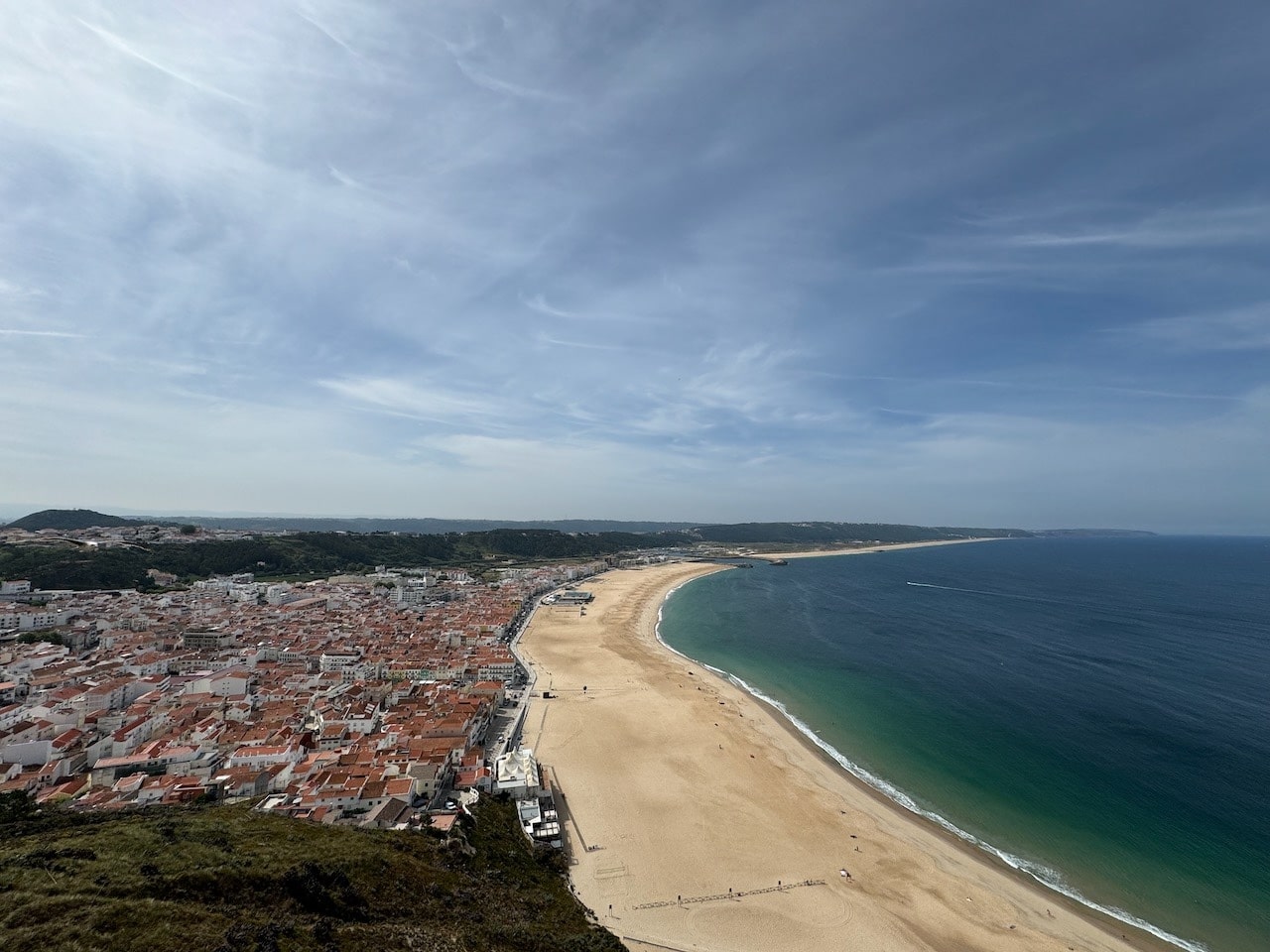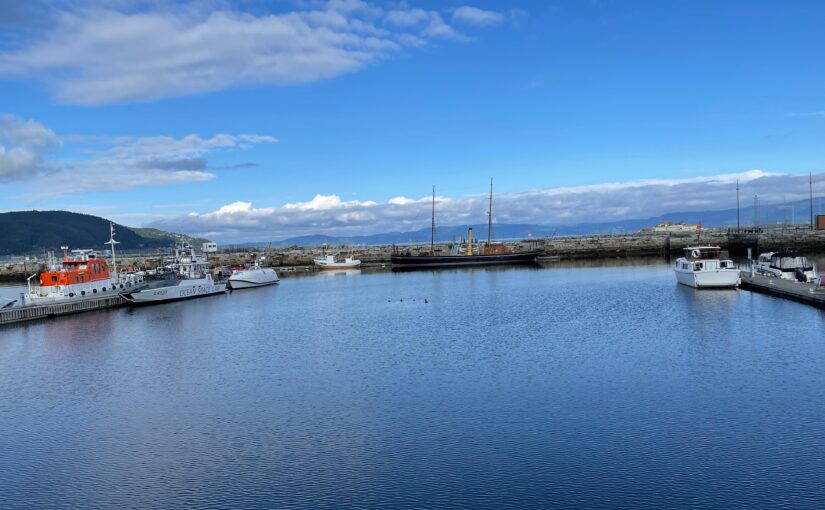by Nick Taylor and Barbara Nevins Taylor
We put Porto at the top of our destination list when we decided to go to Portugal. But we only had three days in Porto and the Douro Valley and we hoped that we could cram everything in.

Photos and videos of the Douro Valley made it seem irresistible. Since it was only, at most, two hours away from the city of Porto we thought a day trip would be doable. But figuring out that portion of the trip was a challenge.
We left the beach town of Nazaré and headed north without a clear plan for what we would do.

The two-hour drive was easy, but once we left the highway and turned on to the road that followed the Douro into Porto, the crazy traffic surprised us.

The road almost dead-ended into a car-restricted zone. Our hotel, the Pestano Vintage Hotel, created from 18 buildings, some dating to the 16th Century, was right in the middle of the UNESCO World Heritage portion of the city. The Pestana provided good instructions in advance and a quick call brought a hotel staffer out to our car to guide us.

He got in and talked us through a tunnel to a parking lot just outside the town center.

Then he expertly pulled our suitcases along the river walkway, talking all the time about the glories of a Douro River tour. “What’s it going to be? A six bridges tour, or a van and a Douro Valley vineyard tour?” he asked excitedly as though he were going on the trip.
The bridges tour was essentially a top-to-bottom river view of Porto. We’d board one of the restored rabelos — traditional cargo boats that once ferried goods and people up and down the river — and pass under the city’s six bridges. It wouldn’t take that long, about an hour, but we’d be with a lot of other people.

Another choice was to take a 10-hour trip that included a van ride to the Douro Valley and another boat ride with a lot of people, then a winery tour, then a van ride back. We listened as he explained it all and felt more confused than we felt at home when we were looking at all the online ads for tours. But in a few minutes we were in the lovely hotel that links the 18 historic buildings.

We liked the idea of being in the center of an ancient city. Porto’s history appealed to us. Archeologists discovered remnants of a Phoenician trading center that dates to the 8th Century BCE. The location just two miles up the Douro River from the Atlantic made it a natural commercial and strategic hub over the centuries.

And it attracted all the A-list conquerors. Romans arrived in the 1st century CE, named it Portus and stayed for 500 years. German tribes including the Visigoths came with the decline of Rome, and Normans claimed the city and the river that led up into fertile hills. Then in the 8th century, North Africans from the Umayyad Caliphate, known as the Moors, took the city and held it along with other parts of Iberia for centuries. Christian Crusaders eventually won Porto and and by the 12th century it was firmly part of a Christian kingdom. Since then it has been at the heart of significant Iberian Peninsula events including Napoleon’s battle for this part of Europe, and military and trade alliances with the English against the French. We hoped to see some of that history reflected in contemporary Porto.
But tourists were the first thing we saw. Yes, just like us. But wow! Tourists flooded the river city.

Our hotel room window faced the Douro and the Praça da Ribeira, a square with restaurants and performers and everything else.

We live in Manhattan in the tourist heart of Greenwich Village and like tourists because they boost the economy. But on vacation, we generally prefer moving off the beaten path. Porto is very much on the path and a place where people were looking at the sights and having fun.

We decided to embrace it and joined the other tourists crossing the Dom Luis I Bridge between Porto and Vila de Nova Gaia where many of the port warehouses are located.

The double-decked iron bridge, completed in 1886, was designed by Théophile Seyrig, a student of Gustave Eiffel. It was considered a marvel of its time. Now it’s a tourist destination.

Back at the hotel, we claimed our complimentary glasses of port just a little shy of cocktail time. Nick had red and Barbara had white — very sweet and very potent because it is a fortified wine spiked with brandy.

Port’s creation dates to 1703 and a treaty that led to a steady export of Portuguese wine to England. To preserve and stop the fermentation during the the sea voyage, winemakers added a small bit of brandy. The wine gained so much popularity that by 1757, the Douro Valley was designated as the only region that could produce Port with a capital P. The English became big players in producing and creating the port industry. Today many of the port cellars across the Douro from Porto have prominent English names.

At dinner that evening at Semea, an offshoot of the Michelin starred Euskalduna, we talked about going to the Douro Valley the next day. But first we had the food and wine. The menu here changes regularly and everything starting with the bread was excellent.



The next morning, after a big breakfast at the hotel, we set off for the Douro Valley. All of the ads and promos on the Internet overwhelmed us. We wanted something simple without a lot of people and we couldn’t seem to find it without it costing more than our hotel room. We have to say that we did meet people who took the tours and had a great time. We went our own way, though, and found that once off the A4, this gas station in Paços felt like the gateway into the valley.

We turned south and suddenly we were in the hills on a twisty two-lane road that wound through the heart of the wine country.

The Duoro River starts in Spain and meanders for almost 600 miles before it flows into the Atlantic at Porto.

The Douro wine region, where dozens of grape varieties are grown and over 80 wineries call home, is only 60 miles or so from Porto. But we felt like we had entered another world. The roadside vistas were an invitation to slow down and smell the grapes.



We stopped in Provesende and looked down on vineyards that ordered the hillsides into neat patchworks. Provesende is important in Portugal’s wine history. Romans began producing wine there and essentially began the wine industry in northern Portugal.
But by the late 19th century, the grapevine insect pest phylloxera was destroying vineyards all over Europe. In Provesende, Joaquim Pinheiro de Azevedo Leite Pereira had been applying scientific techniques to growing at Casa do Santo, the family’s quinta, or wine estate.

He experimented and saved his vines by grafting resistant American root stocks to them. Other winemakers followed his example and Pereira became known as the Savior of the Douro. Casa do Santo’s still in business, and its wines are highly rated. Descendants of Pereira turned one of the houses on the estate into a B&B that also gets good reviews.
But we drove on and the road turned and crossed the river into the town of Pinhâo.

We wandered around a bit and looked at the train station with the beautiful tiles where many people arrive to start their Douro Valley tour, but we didn’t linger.


We re-crossed the bridge and drove down the Duoro and started looking for someplace to eat. That’s how we found the Quinta de la Rosa winery and its restaurant Cozinha da Clara perched high above the river. Parking required some gymnastic moves but our terrace table overlooking the river was worth the trouble.

Most of the restaurant’s guests appeared to be staying at the hotel and could enjoy the quinta’s wines.

We were driving and that meant lunch without wine, but we still had a birds eye view of the tour boats.
This was the typical small boat with a deck full of passengers that was part of the van-to-boat-to-vineyard tours.

We also saw one of the cruise ships gliding along the river that offer a more leisurely tour. This one was by the Uniworld tour company. Several friends have taken the Viking cruise up the river from Porto to Spain and enjoyed the quiet beauty.

But we didn’t regret our decision to come to wander, have a meal and head back to Porto.
After a day in the car, we were happy to discover that the restaurant we had booked in an advance was an easy walk up the hill from our hotel. Restaurant DOP was on Michelin’s recommended list, and its owner and chef Rui Paula is heralded as one of Portugal’s modern cuisine pioneers. We chose one of the tasting menus and each dish seemed too pretty to eat. But you know what happened.


We oohed and ahhed with every dish and every bite.



Eating like this would be gluttony if the servings were not elegantly small.
The next morning after breakfast, we set out to explore what we had not yet seen in Porto. We made the uphill walk, which took us out of the ribiera district. The photo is looking back.


The streets wound round and round up the hill. And we were happy to discover that the walk led us through Porto’s Sâo Bento train station, which seemed to be as much of a tourist attraction as just about everything else in the city.

Travel is certainly the point here. But you’re missing something if you don’t stop to look at the showcase of azulejos art. Sâo Bento, built in the early 20th century, features an estimated 20,000 tiles by the artist Jorge Colaço created between 1905 and 1916.

The tiles depict historical scenes, battles, and Douro Valley life. If you look closely you see that the top panel depicts the harvest and the bottom gives us boats taking the wine down river.

Of course, some people don’t look up.
Back out on the street, a few more twists and turns and we found the market, another joyous riot for the senses.

There is a bounty of fruit and flowers and produce, olive oil and candy in the center of the big open space and locals shopping.





But the stalls along the side walls draw the tourists for wine tasting.

And arresting displays of seafood.


And game.


The bite-size pieces of venison on toast and seafood for 5 and 6 euros were the big draw.

We along with many others couldn’t resist.

To head to our next destination, we had to walk up a flight of stairs to the exit to the street, and that was something else. We got caught up in the play-it-yourself musical instruments available to all.

Wandering from the market, we passed Porto’s city hall with its clock tower facing a long square named for General Humberto Delgado.

Humberto Delgado was a founder of TAP Airlines and a general in the Portuguese Air Force, but he’s best known as an anti-fascist politician who faced down prime minister and dictator Antonio Salazar in 1958, fled to Brazil, and later founded the Portuguese National Liberation Front. He was murdered in 1965 by an agent of Salazar when he tried to re-enter Portugal from Spain.
A visit to Porto wouldn’t be complete without a visit to the Livraria Lello, the bookstore thrust into worldwide fame as the Hogwarts Library in the Harry Potter movies.

The place was overwhelmed with people and now takes reservations online and charges 8 euros to get in and you get a discount on a book purchase. For 15.95 euros, you get a book from the store’s collection.
We managed a reservation at the last minute and jostled with a lot of other oglers browsing its shelves and posing for pictures on the ornate staircase. The woman with her back to the camera posed there for 10 minutes. We’re not kidding.

We searched for English translations of new Portuguese mysteries or police procedurals, but the translators hadn’t gotten to them yet. Disappointed, we bought a puzzle that shows the staircase to share with family at Thanksgiving. Readers seemed to be in a minority among the visitors for whom the store was more about photos and the staircase than anything else.

Back out on the street, not far from the Livraria we found the The Banco de Mateirais or Bank of Materials, which cherishes the past in a different way. The bank, open to the public as a museum, stores tens of thousands of hand-painted tiles or azulejos from Porto’s decaying buildings, many of which were built in the 19th century.

Tiles, and architectural details, are often rescued if a building is demolished or so decrepit that is a target for thieves. If a building owner needs a replacement tile or other architectural ornament, they might find them here and take them for free. If the bank doesn’t have the the azulejo, or architectural ornament, they might even help find someone to replicate it.


By late afternoon, we walked back down to the river and stopped at Casa Lopes for an octopus salad.

The small cafe was on a street just behind our hotel, and during our three days in Porto had become our quiet place to review the day and think about what would come next.

That night, what came next was a big contrast to Casa Lopes and was one of the splashiest bits of our trip, although we didn’t know it beforehand.

We arrived at Elemento, a Michelin recommended restaurant, and found ourselves seated at the chef’s bar to watch the show and eat. Everything here is cooked over wood fire, or smoked in a coal oven. Ricardo Dias Ferreira, the owner and chef, describes this kind of cooking as his “dream.” The immersive experience of watching the preparation, feeling the heat of the fire and smoke while we enjoyed each dish, made us feel as though we were caught up in a dream of his making.
We began this way with tartelete with cristal prawn from Algarve, strawberrys tomato, cucumber and bechamel sauce.

And then king fish cured in citrus with a smash of coriander.

And went on to red prawn in smoked clam sauce.

Mackerel with parley sauce and seaweed.

And then turbot with smoked clam sauce and fresh spinach.

While we ate and drank Portuguese wine, we watched the chefs assemble the beautiful plates.

We appreciated the intensity that went into preparing every plate. This is roast suckling pig with Tuscan kale and orange and elderflower sauce.

And this is lamb with a razor clam emulsion and kohlrabi.

As the evening wore down and we were among the last guests at the chef’s bar, Nick asked the chef who was working right in front of us, if he watched “The Bear.” His face lit up and he said, “Oh sure. I bet everyone here does.”
We savored the highlights as we left Porto the next morning, but there were highlights ahead. We were headed for Coimbra, Portugal’s “City of Knowledge.”



